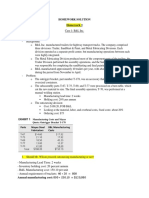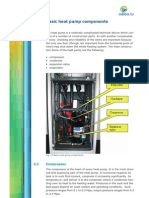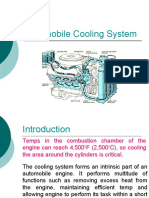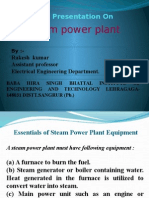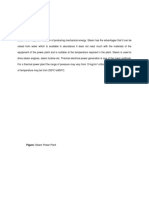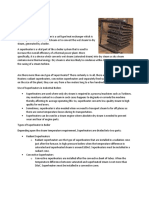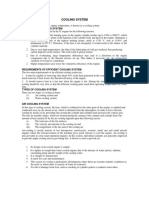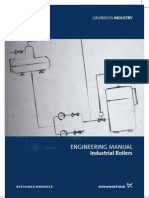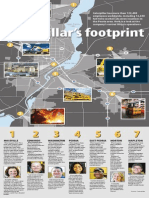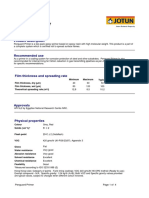Steam Turbine Auxiliaries: Biomass Power Plant
Steam Turbine Auxiliaries: Biomass Power Plant
Uploaded by
Hithesh U WarrierCopyright:
Available Formats
Steam Turbine Auxiliaries: Biomass Power Plant
Steam Turbine Auxiliaries: Biomass Power Plant
Uploaded by
Hithesh U WarrierOriginal Description:
Original Title
Copyright
Available Formats
Share this document
Did you find this document useful?
Is this content inappropriate?
Copyright:
Available Formats
Steam Turbine Auxiliaries: Biomass Power Plant
Steam Turbine Auxiliaries: Biomass Power Plant
Uploaded by
Hithesh U WarrierCopyright:
Available Formats
Steam turbines are one of the major drivers of power generators in todays power plants.
There are several types of turbines and a number of mechanical arrangements to obtain maximum efficiency and output. The auxiliaries however are very similar, performing equally important tasks in their systems.
Steam Turbine Auxiliaries
Introduction In the previous article on power plant auxiliaries we looked at the important part played by the auxiliaries of a dual drum water tube boiler. Following on from there, here we will examine the main auxiliaries of the associated steam turbine, using the same method of locating and describing the functions of the different components within the relevant systems. Please refer to the drawing to when reading the component descriptions which are numbered in sequence as in the descriptions.
Lube-oil System
1. Pumps The lubricating oil system has three separate pumps which supply the bearings and hydraulic system with oil.
Biomass power plant
www.hfdepo.com
top supplier who has the key techno -logy to convert biomass to energy.
Mobil Industrial Greases
www.Mobilindustrial.com
For Better Performance,Problem Free Operation & Extend Re-Lubrication.
steam turbine power plant
www.usedturbinesales.com
80MW steam turbines and boiler blast furnace gas or heavy fuel oil
Ads by Google
Lube oil Jacking pump this is used when the turbine is being rotated by the turning gear. Emergency Lube oil Pump this cuts in if the turbine trips through loss of power. Lube oil Booster Pump this pump is used at start-up and ensures an adequate flow at slow speeds. It cuts out when the turbine reaches operation speed Main lube oil pump this pump draws the oil from a lube oil tank and supplies the turbine bearings and governor. This is normally a centrifugal pump driven by the turbine or generator shaft.
2. L.O. Filters Some systems have duplex filters on the suction and discharge pipework of the pumps, but at a minimum a set on the discharge. These remove any debris picked up by the oil before the oil is fed to the bearings. 3. L.O. Coolers The oil lubricates the bearings absorbing the heat from friction. This heat is dissipated by the coolers. These are usually tube coolers, water being the medium used to cool the oil. 4. L.O. Centrifuge The centrifuge is usually positioned above the lube oil tank and runs continually whilst the turbine is operating, only coming off line for cleaning. It draws the lube oil from the lube oil tank removing any water and particles by centrifugal force before discharging the clean oil back to the tank. 5. Turbine Governor As the loads on the generator vary requiring more or less steam to the turbine, the governor responds by controlling the speed of the turbine. The governor is hydraulically operated by lube oil supplied by the main pump.
The Steam Condensate System
6. Steam Turbine Condenser Expanded steam from the low pressure turbine is drawn into the tube condenser by a vacuum which is maintained at 28"29"Hg where it is condensed by water which has been cooled in the cooling tower. 7. Air Ejector The air ejectors are used to create the initial vacuum in the condenser and maintain a vacuum of 28-29"Hg for optimum steam evaporation. The ejectors draw the air out of the condenser by passing high pressure steam through a vortex piping arrangement thus causing the vacuum. 8. Condensate Pump This pump draws the water from the bottom of the condenser or hotwell and pumps it up to the deaerator. 9. Tray Deaerator This is a pressure vessel with a horizontal and vertical section somewhat like a comic strip submarine shape. It effectively removes the air and oxygen from the feed water (condensate) which would otherwise damage the inside of the boiler tubes by corrosion. There are several types of deaerators; we will look at the tray type which is a vessel having a horizontal section with a vertical dome. The bottom horizontal section is used to collect and store the deaerated water; the vertical section has perforated trays set at intervals along its upper length. The condensate enters at the top of the vertical section cascading down through the trays, meeting steam injected from the sides and gathers at the bottom section where it is heated by steam coils or sprays. The air is vented from the very top of the deaerater vertical domed section. 10. Boiler Feed Pump This pump takes the water from the deaerator and pumps it through a series of feed heaters into the boiler economizer (see boiler auxiliaries article) and into the boiler top drum through the feed water control valve. The water used to condense the steam to condensate is now pretty hot itself, so it needs to be cooled down before being used again. The cooling tower is used for this purpose. It is a vertical hyperboloid concrete structure with a honeycombed interior usually of plastic and the water enters at the top cascading down through the plastic sections. It draws in air from the bottom, which rising up through the tower mixes with the water thus cooling it helped by evaporation, the resultant plume rising out of the top of the tower. 12 Cooling Medium Pumps These pumps circulate the cooling medium from the main vacuum condenser and LO cooler to and from the cooling tower.
Steam Turbine flow Diagram Showing Auxiliaries
- See more at: http://www.brighthubengineering.com/power-plants/60844-fossil-and-biomass-fueled-powerplants-steam-turbine-auxiliaries/#sthash.CPOFt2is.dpuf
You might also like
- HW3 SolutionDocument6 pagesHW3 SolutionAnh Cao Thị MinhNo ratings yet
- Boiler Operation Engineer Exam, Interview Q&A, Terminology, and Boiler OverviewFrom EverandBoiler Operation Engineer Exam, Interview Q&A, Terminology, and Boiler OverviewRating: 4.5 out of 5 stars4.5/5 (3)
- Boiler and Turbine For BOE ExamDocument71 pagesBoiler and Turbine For BOE Examkeerthi dayarathna100% (1)
- Diesel Power StationDocument30 pagesDiesel Power StationGerald EmmanuelNo ratings yet
- Diesel Power PlantDocument6 pagesDiesel Power Plantsourabh singh tomerNo ratings yet
- Turbine AuxillariesDocument139 pagesTurbine AuxillariesAwez Rana100% (1)
- PMDDocument17 pagesPMDmasrydrarNo ratings yet
- Steam Boiler Operation and AuxiliariesDocument9 pagesSteam Boiler Operation and Auxiliariesshin deiruNo ratings yet
- Diesel Engine ReportDocument100 pagesDiesel Engine ReportAshraful Haque100% (1)
- Aee Notes Module 1Document26 pagesAee Notes Module 1PEC18ME003 AbhiRam SRNo ratings yet
- Class 4. Steam Power PlantDocument37 pagesClass 4. Steam Power PlantsureshlalNo ratings yet
- 34 Boiler AccessoriesDocument21 pages34 Boiler AccessoriesSwaraj TodankarNo ratings yet
- Engine Systems For PasgtDocument27 pagesEngine Systems For PasgtJeric AristozaNo ratings yet
- Study of Components, Systems & Working of Diesel Engine ModelDocument11 pagesStudy of Components, Systems & Working of Diesel Engine ModelFaisal NaeemNo ratings yet
- Marine Steam TurbinesDocument23 pagesMarine Steam TurbinesBlix KaneNo ratings yet
- PPS Steam Boiler Operation and AuxiliariesDocument9 pagesPPS Steam Boiler Operation and AuxiliariesAraNo ratings yet
- Basic Heat Pump ComponentsDocument6 pagesBasic Heat Pump Componentsdrabc123No ratings yet
- Liquid Cooled SystemsDocument9 pagesLiquid Cooled Systemsananth k rNo ratings yet
- Title of Project-: Preliminary Study On Thermal Power Plant and Detail Study On Coal Handling PlantDocument98 pagesTitle of Project-: Preliminary Study On Thermal Power Plant and Detail Study On Coal Handling PlantAbir MukherjeeNo ratings yet
- Automotive Cooling SystemDocument58 pagesAutomotive Cooling SystemMoniruzzaman ShuvoNo ratings yet
- Expt. # 03 Study of A Steam Turbine Power PlantDocument6 pagesExpt. # 03 Study of A Steam Turbine Power PlantSajeeb SarkerNo ratings yet
- Turbocharger 2NDDocument6 pagesTurbocharger 2NDkyaw yaNo ratings yet
- Steam Power Plant and BoilersDocument101 pagesSteam Power Plant and Boilersjamunaa83100% (1)
- Steam Turbine Power Plant: Process Flow DiagramDocument3 pagesSteam Turbine Power Plant: Process Flow DiagramTaqdees AhmadNo ratings yet
- Turbine Auxiliaries - Arrangement of Turbine Auxiliaries - ALL ABOUT POWER PLANTDocument14 pagesTurbine Auxiliaries - Arrangement of Turbine Auxiliaries - ALL ABOUT POWER PLANTKolahalam Rakeshraju100% (2)
- Classification, Valve Timimg and Cooling System 2425Document73 pagesClassification, Valve Timimg and Cooling System 2425juniorjrjohansen10No ratings yet
- AES Thermal Power Plant, Lalpir, District Muzaffargarh: Prepared byDocument25 pagesAES Thermal Power Plant, Lalpir, District Muzaffargarh: Prepared byIrfan UllahNo ratings yet
- Gas TurbineDocument8 pagesGas TurbineKALPUSHNo ratings yet
- Diesel & Gas Power plant-PPE - Unit-IIDocument14 pagesDiesel & Gas Power plant-PPE - Unit-IISacet 2003No ratings yet
- Thermo Ex.4Document5 pagesThermo Ex.4Hafeez AliNo ratings yet
- Cooling System in Transformer and CarDocument9 pagesCooling System in Transformer and CarAizaz KhanNo ratings yet
- 2013edusat Lecture On STEAM PLANTDocument101 pages2013edusat Lecture On STEAM PLANTKishore KrishnaNo ratings yet
- New Mini ProjectDocument8 pagesNew Mini ProjectfarahNo ratings yet
- Boiler Cont.Document9 pagesBoiler Cont.adnan mukhtarNo ratings yet
- Thermal Power PlantDocument17 pagesThermal Power PlantraghuvarmaNo ratings yet
- Unit-02 Combined Complete - 23920146 - 2024 - 11 - 23 - 17 - 33Document95 pagesUnit-02 Combined Complete - 23920146 - 2024 - 11 - 23 - 17 - 33poojakashyap9591No ratings yet
- Qip Ice 12 Fuel Injection SystemsDocument40 pagesQip Ice 12 Fuel Injection SystemsAnonymous eyxVFR100% (1)
- UNIT IV - Engine Cooling SystemsDocument55 pagesUNIT IV - Engine Cooling SystemsANSH ROHATGI (RA2111011010002)No ratings yet
- Diesel Fuel SystemDocument36 pagesDiesel Fuel SystemFeckry Ag Ghani100% (1)
- Steam Power PlantsDocument18 pagesSteam Power Plantscan canNo ratings yet
- Industrial Plants AssignementDocument11 pagesIndustrial Plants Assignementjoseph james makafuNo ratings yet
- 1Document4 pages1Issa Mae ObogNo ratings yet
- Engine Simulator Room FamiliarizationDocument93 pagesEngine Simulator Room FamiliarizationJohnarey Galve PantuaNo ratings yet
- Diesel Engine TechnologyDocument59 pagesDiesel Engine TechnologyAnonymous f2zDTm7kmNo ratings yet
- Preparations, Operation and Safety Measures For Main EngineDocument35 pagesPreparations, Operation and Safety Measures For Main Engineart estacioNo ratings yet
- Mr. Hassan Alam: Heat Recovery Boiler of SNPC Power PlantDocument11 pagesMr. Hassan Alam: Heat Recovery Boiler of SNPC Power PlantYashal Syed, AhmedNo ratings yet
- Jagan Steam Power PlantDocument101 pagesJagan Steam Power PlantMahender VangalaNo ratings yet
- 3 Pps Final Modules 910111213Document12 pages3 Pps Final Modules 910111213KyleNo ratings yet
- Schematic Arrangement of Diesel Power Station (I) Fuel Supply SystemDocument4 pagesSchematic Arrangement of Diesel Power Station (I) Fuel Supply Systemgayathri gayuNo ratings yet
- Steam PlantDocument102 pagesSteam PlantPrakhar Shukla100% (1)
- Unit-3: Diesel Power Plant LayoutDocument12 pagesUnit-3: Diesel Power Plant LayoutPavankumar PavankumarpvNo ratings yet
- Cooling SystemDocument2 pagesCooling SystemPrem MishraNo ratings yet
- Working Principle of The Different Auxiliary MachineryDocument24 pagesWorking Principle of The Different Auxiliary MachineryBSMAR-E 1A, ESTRELLA JOSE CARLOS ELISEO100% (1)
- Automobile 6th SemesterMechanicalDocument25 pagesAutomobile 6th SemesterMechanicalSumit ManwarNo ratings yet
- Cooling and LubricationDocument8 pagesCooling and Lubricationbashirkiganda696No ratings yet
- Boiler Feed PumpDocument32 pagesBoiler Feed PumpAli Bari100% (2)
- Operator's Guide to General Purpose Steam Turbines: An Overview of Operating Principles, Construction, Best Practices, and TroubleshootingFrom EverandOperator's Guide to General Purpose Steam Turbines: An Overview of Operating Principles, Construction, Best Practices, and TroubleshootingRating: 5 out of 5 stars5/5 (1)
- Comparison of Diesel and Petrol EnginesFrom EverandComparison of Diesel and Petrol EnginesRating: 2.5 out of 5 stars2.5/5 (3)
- Minerals Notes CBSE 10 TH Grade Social StudiesDocument5 pagesMinerals Notes CBSE 10 TH Grade Social Studiesmurugan1818No ratings yet
- Assignment OF Global Logistics & Supply Chain OperationsDocument18 pagesAssignment OF Global Logistics & Supply Chain OperationsAmit Pal SinghNo ratings yet
- Designed and Made in EuropeDocument35 pagesDesigned and Made in EuropeSebastian De Ossa RestrepoNo ratings yet
- 12 Mr. Christensen, Nosering Case StoryDocument20 pages12 Mr. Christensen, Nosering Case StoryJunaid MazharNo ratings yet
- A Study of Cost Comparison of Precast Concrete vs. Cast-In-PlaceDocument4 pagesA Study of Cost Comparison of Precast Concrete vs. Cast-In-PlaceEditor IJRITCC100% (1)
- Maintenance and Reliability: © 2011 Pearson Education, Inc. Publishing As Prentice HallDocument55 pagesMaintenance and Reliability: © 2011 Pearson Education, Inc. Publishing As Prentice HallAle MariaNo ratings yet
- Caterpillar's FootprintDocument1 pageCaterpillar's FootprintJournal StarNo ratings yet
- CaseHard BS970-1955EN36ADocument2 pagesCaseHard BS970-1955EN36AtechzonesNo ratings yet
- Magna Carta For S and T PersonnelDocument3 pagesMagna Carta For S and T PersonnelElena LlasosNo ratings yet
- DE - CM 402 BFT.v02 PDFDocument13 pagesDE - CM 402 BFT.v02 PDFDaryanto GultomNo ratings yet
- Electrode Brad Qualification Procedure As Per ASME Section II Part C Along With NPCIL ProcedureDocument2 pagesElectrode Brad Qualification Procedure As Per ASME Section II Part C Along With NPCIL ProcedurePrashant Puri100% (2)
- Business Environment 4Document105 pagesBusiness Environment 4Jasmandeep brarNo ratings yet
- NAV22-Welding Weld Repair Audit ChecklistDocument21 pagesNAV22-Welding Weld Repair Audit ChecklistDino Peduto100% (1)
- Operations Management: Lecture NotesDocument68 pagesOperations Management: Lecture Notesasif lashariNo ratings yet
- Line Balancing Line Balancing: Pemp Emm515Document56 pagesLine Balancing Line Balancing: Pemp Emm515vehlajattNo ratings yet
- Turbine Flow Sensor & MeterDocument12 pagesTurbine Flow Sensor & MeterBroiltechNo ratings yet
- Box Basics - BoxmasterDocument7 pagesBox Basics - BoxmastermichelbgggNo ratings yet
- Avdel Threaded Insert Brochure 07 03Document48 pagesAvdel Threaded Insert Brochure 07 03jshinockNo ratings yet
- Technical Data Sheet F Peng 201504Document1 pageTechnical Data Sheet F Peng 201504Anonymous VRspXsmNo ratings yet
- Lecture 1 Introduction Types of ConstructionsDocument27 pagesLecture 1 Introduction Types of Constructionsapi-297436547No ratings yet
- TDS - Penguard Primer - Issued.26.11.2010Document4 pagesTDS - Penguard Primer - Issued.26.11.2010vitharvanNo ratings yet
- Img 20201104 0001 PDFDocument1 pageImg 20201104 0001 PDFام ايوب امة اللهNo ratings yet
- A 917Document3 pagesA 917bennNo ratings yet
- Properties of Stainless SteelsDocument22 pagesProperties of Stainless Steelsngoclinh87No ratings yet
- Catalog KnuthDocument252 pagesCatalog Knuthlorenzinho290No ratings yet
- EAWI023RCDocument75 pagesEAWI023RCconstp2100% (1)
- Open Die ForgingDocument6 pagesOpen Die ForgingMahade Hasan DipuNo ratings yet
- Brother Scan N Cut Materials Test List Version 2Document1 pageBrother Scan N Cut Materials Test List Version 2Misty Latham-RubashNo ratings yet
